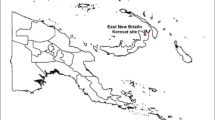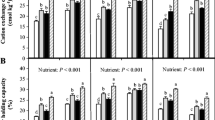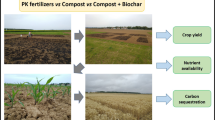Abstract
Soil amendments, such as compost and biochar are known to affect soil properties, soil microbial activity, and plant growth. These organic amendments have the ability to increase soil fertility, carbon sequestration, and crop productivity. However, there is limited information available on the integrated application of biochar and compost on microbial and enzymatic activity, nutrients availability and plant growth in arid soil. The present study was designed to quantify the effect of biochar along with compost on soil microbial biomass (carbon, nitrogen, phosphorus), enzyme (urease, alkaline phosphatase, dehydrogenase) activity, nutrients (N, P, K) availability in soil, and plant growth. The treatments comprise a control, biochar at 20 g kg−1 soil, compost at 20 g kg−1 soil, biochar + compost at (10 g kg−1 soil + 10 g kg−1 soil), biochar + compost at (15 g kg−1 soil + 5 g kg−1 soil), and biochar + compost at (5 g kg−1 soil + 15 g kg−1 soil). Tomato was grown as a test plant in the pot experiment. The results revealed that biochar and compost alone or in combinations proved statistically significant for Soil pH. Application of biochar at 20 g kg−1 soil proved useful and increased (130%) microbial biomass carbon (MBC) as compared with control. Compost at 20 g kg−1 soil increased alkaline phosphatase (143%), urease activity (10%) and plant nitrogen (33%) over control. However, microbial biomass nitrogen (MBN), and dehydrogenase activity increased by 62, and 100% respectively in the treatment receiving biochar and compost at 10 + 10 g kg−1 soil compared to that in the control. Plant phosphorus and potassium contents were 34 and 70% higher in the treatment receiving biochar and compost at 5 + 15 g kg−1 soil than in the control. However, for plant parameters (plant height, plant fresh weight, and plant dry weight), the combination of biochar and compost at 15 + 5 g kg−1 soil was superior to other treatments.
Similar content being viewed by others
Introduction
Biochar is formed in the absence of oxygen by thermal degradation of organic materials (pyrolysis) and is different from charcoal. It can be produced from a variety of biomass sources, such as corn cob, tea waste, woody materials, olive husk, green waste, and other agricultural wastes, manures, and other waste products (Chan et al. 2008). Biochar gives the opportunity to enhance nutrient-use efficiency and soil fertility by using commonly reusable and available materials in a stable way. Productivity and soil health are not only improved by biochar but it also helps in carbon dioxide sequestration and overcome global warming. Nutrient retention of soil is increased by biochar which enhances its effecient utilization (Lehmann 2007).
Composted organic materials are good source of macro and micronutrients and it also improve the soil characteristics such as aeration, water holding capacity, bulk density, aggregation, cation exchange capacity, and beneficial microflora activity (Jilani et al. 2007). Municipal solid waste (MSW) is a mixture of inorganic and organic materials, and its per capita generation and composition may vary from country to country. Because of several factors including dietary habits, cultural traditions, lifestyle, climate, and income (Jilani et al. 2007). Soil microbial biomass has been increased by the addition of biochar (Liang et al. 2010). It is mostly believed that the microbes are mostly unavailable in the majority of the biochar carbon; however, there is also proof that soil microbial biomass activity and growth are increased by biomass-derived charcoal (Steiner et al. 2008).
The addition of organic matter can improve soil fertility which is provided by water holding capacity and nutrient availability, and it also provides energy for micro-organisms which are present in soil. The municipal solid waste composting is being encouraged in many countries of the world, and researchers have experienced the benefits of using MSW compost in the field. Organic amendments have the capability to increase carbon sequestration, soil fertility, soil water retention, and crop productivity. Biochar and compost could act in a similar manner like as organic amendments used in the studies mentioned previously. Biochar and compost could be used to improve soil chemical properties and minimize P fixation in soils (Galinato et al. 2011).
The present study was therefore designed to quantify the effect of biochar along with compost on soil microbial biomass (carbon, nitrogen, phosphorus) and enzyme (urease, alkaline phosphates, dehydrogenase) activity and to evaluate the effect of biochar plus compost on nutrient (N, P, K) availability in soil and plant.
Materials and methods
Biochar and compost preparation
Rice husk (Oryza sativa) feedstock was collected and used for biochar production in a conventional biochar tank at 350 °C for 3 h. The prepared biochar was stored in a plastic bag after cooling. Biochar was analyzed for physiochemical properties. However, compost was taken from a project of PMAS Arid Agriculture University, Rawalpindi. The basic properties of biochar and compost are given in Table 1.
Pot experiment
Pot experiment was conducted in the glasshouse at Pir Mehr Ali Shah Arid Agriculture University, Rawalpindi. The soil was collected from University research farm. The soil was air-dried, ground, passes through 2 mm sieve, and analysed for basic physico-chemical properties. The results are given in Table 2. Eighteen pots were prepared to accomodate six treatment in triplicate. Each pot was filled with 5 kg of prepared soil. The treatments were as follows:
-
1.
Control
-
2.
Biochar 20 g kg−1 soil
-
3.
Compost 20 g kg−1 soil
-
4.
Biochar + compost (10 g kg−1 soil + 10 g kg−1 soil)
-
5.
Biochar + compost (15 g kg−1 soil + 5 g kg−1 soil)
-
6.
Biochar + compost (5 g kg−1 soil + 15 g kg−1 soil)
Tomato seedlings (Solanum lycopersicum) were transplanted and grown for 2 months in a pot. At harvest, soil and plant samples were collected. Soil samples were analyzed for microbial biomass carbon (MBC), microbial biomass nitrogen (MBN) and microbial biomass phosphorus (MBP), and soil enzyme activities like urease, alkaline phosphatase, and dehydrogenase. However, N, P, and K were analyzed in both soil and plant.
Analytical methods
Soil samples were analyzed for soil pH and electric conductivity (EC) using a soil-to-water suspension of 1:2.5 by Page et al. (1982). Nitrate-N was determined by using the salicylic acid method (Vendrell and Zupanicic 1990). Available phosphorus was determined by spectrophotometer (Olsen et al. 1954), and extractable potassium (Rhoades 1982) was determined by flame photometer. Soil microbial biomass carbon, nitrogen, and phosphorus were determined by the fumigation-extraction method (Brooks et al. 1985). Soil alkaline phosphatase activity was determined using the method described by Elvazi and Tabatabai (1977). Urease activity was determined using the method described by Kandeler and Gerber (1988). Dehydrogenase activity was measured using the method described by Alef and Nannipieri (1995).
Statistical analysis
The experiment was arranged in a completely randomized design (CRD) with three replications. The data collected were analyzed by one-way ANOVA, and treatment means obtained were compared by LSD at 5% level of significance (Steel and Torrie 1997).
Results and discussion
Soil pH and EC
The results showed that the treatments had significant effect on Soil pH (Fig. 1). The maximum soil pH (8.33) was observed in the treatment where biochar was applied at 20 g kg−1 soil. The lowest soil pH of 7.22 was recorded for the treatment where biochar plus compost was used at 5 + 15 g kg−1 soil. Maximum soil EC (0.43 dS m−1) was observed in the soil treated with biochar at 20 g kg−1 soil and minimum was recorded (0.14 dS m−1) for the treatment receiving compost at 20 g kg−1 soil (Fig. 1).
Soil microbial biomass (carbon, nitrogen, and phosphorus)
The results revealed that the maximum MBC (278 mg kg−1) was recorded for soil receiving biochar at 20 g kg−1 soil, and a minimum value of MBC (122 mg kg−1) was recorded for soil receiving compost at 20 g kg−1 soil (Fig. 2). The values remained 130% and 10% higher for biochar- and compost-treated pots respectively than that of control (120 mg kg−1). The increase in MBC might be due to the high carbon content of biochar which might increase soil organic carbon contents. The studies of Kolb (2007) support the present study that MBC is significantly increased with biochar addition in the soil.
The combined application of biochar and compost at 10 + 10 g kg−1 soil gave the highest value (44.50 mg kg−1) for microbial biomass nitrogen (MBN) (Fig. 2). It was significantly higher (62%) than that of the control (27.40 mg kg−1) pot. The lowest value (24.66 mg kg−1) was recorded for the treatment receiving biochar at 20 g kg−1, and it was significantly lower (10%) than that of the control pot. The possible reason behind is sorption of inorganic nitrogen with biochar. Dempster et al. (2011) while applying Eucalyptus marginata biochar at rate 0, 5, and 25 t/ha in a coarse-textured soil noticed that the MBN remained unchanged. They concluded that MBN might be increased due to the application of urea with biochar. The result regarding microbial biomass phosphorus (MBP) differenced significantly with each other. Maximum MBP (6.42 mg kg−1) value was recorded for soil receiving compost at 20 g kg−1 soil (Fig. 2).
Soil enzymes (alkaline phosphatase, urease, dehydrogenase)
Maximum alkaline phosphatase activity (78.6 mg PNP kg−1 h−1) was recorded for the soil receiving compost at 20 g kg−1 soil, and it remained 143% higher than that of control (32.33 mg PNP kg−1 h−1) (Fig. 2). Phosphatase activity with biochar at 20 g kg−1 soil was recorded at 41.43 mg PNP kg−1 h−1, and it was 28% higher than that of control. The increase in phosphatase activity could be due to the alkaline pH of the soil.
Maximum urease activity (598 mg NH4-N kg−1 2 h−1) was recorded for compost at 20 g kg−1 soil (Fig. 2). The values were significantly higher by 43% than that of control (418 mg NH4-N kg−1 2 h−1). Minimum urease activity (436 mg NH4-N kg−1 2 h−1) was recorded for biochar at 20 g kg−1, and it was 4.3% higher than that of control. Maximum dehydrogenase activity (32 μg TPF g−1 min−1) was recorded for the combination of biochar plus compost 10 + 10 g kg−1 soil which was significantly higher by 100% than that of control (16 μg TPF g−1 min−1) (Fig. 2). Minimum dehydrogenase activity (22 μg TPF g−1 min−1) was recorded for compost at 20 g kg−1 soil which was 37% higher than that of control. This increase in dehydrogenase activity might be due to the increase in organic matter with the addition of biochar and compost.
Soil and plant nutrient contents
The maximum value of nitrate nitrogen (16.22 mg kg−1) was recorded for the combination of biochar plus compost at 10 + 10 g kg−1 soil which was 140% higher and significantly better than that of control (6.74 mg kg−1) (Fig. 3). The minimum value of 7.42 mg kg−1 was recorded for the treatment with biochar at 20 g kg−1 soil which was 10% higher and remained nonsignificant with that of control. Biochar at 20 g kg−1 soil and the combination of biochar plus compost at 15 + 5 g kg−1 soil treatments were nonsignificant among themselves. Effect of biochar on nitrate nitrogen was lesser than that of compost. The lowest value of available phosphorus (5.86 mg kg−1) was observed in control. The maximum value of available phosphorus (13.97 mg kg−1) was observed in the treatment with biochar and compost at 10 + 10 g kg−1 soil which was significantly better than that of control (Fig. 3). The lowest value (91 mg kg−1) was observed for extractable potassium in control. The maximum value (139 mg kg−1) for extractable potassium was observed where compost at 20 g kg−1 soil was applied, and it remained significantly better than that of control (Fig. 3). The second highest value (135 mg kg−1) for extractable potassium was observed in the soil receiving a combination of biochar plus compost (5 + 15 g kg−1).
Plant nitrogen recorded for a compost at 20 g kg−1 soil was significantly better than that of control (2.34%) (Fig. 3). Muhammad et al. (2013) studied that the application of organic and inorganic fertilizer application increase nitrogen contents in a tomato plant. Compost applied at the rate of 5 t ha−1 give high contents of nitrogen 3.30%. The maximum value of plant phosphorus was recorded for the combination of biochar and compost at 5 + 15 g kg−1 which was 40% higher and significantly better than that of control (0.44%) (Fig. 3). The value observed in the soil receiving compost at 20 g kg−1 of soil was 34% higher than that of control. Higher value of plant potassium was recorded for combination of biochar with compost at 5 + 15 g kg−1 and it remained significantly better (70%) than that of control (3.44%) (Fig. 3).
Plant growth parameters
Maximum value of plant height was recorded for the combination of biochar plus compost at 15 + 5 g kg−1 soil which was significantly higher than that of control. The lowest value was recorded in the combination of biochar plus compost at 10 + 10 g kg−1 soil (Table 3).
The maximum value in plant fresh weight was recorded for the combination of biochar plus compost at (15 + 5 g kg−1); moreover, it remained significantly different from control. The minimum value was recorded for the combination of biochar plus compost (10 + 10 g kg−1 soil). The maximum value in plant dry weight was recorded at for the combination of biochar plus compost (15 + 5 g kg−1) which was significantly higher than that of control (Table 3).
Conclusions
Application of biochar and compost is a useful strategy to increase soil fertility and plant growth. The combination of biochar and compost at 15 + 5 g kg−1 soil proved superior for plant growth parameters than other treatments including control. However, the response of different soil quality parameter to the combination of biochar and compost is variable. Biochar and compost at 10 + 10 g kg−1 soil enhanced soil microbial properties, such as microbial biomass nitrogen and dehydrogenase activity. However, urease activity was found better in compost treatment at 20 g kg-1. It is suggested that biochar made from different other sources and at different temperature alone and in combination with compost may further be tested in laboratory and field with other crops to explore its impact on soil and plant health.
References
Alef K, Nannipieri P (1995) Methods in applied soil microbiology and biochemistry. Academic Press, London
Brooks PC, Landman A, Pruden G, Jenkinson DS (1985) Chloroform fumigation and the release of soil nitrogen: a rapid direct extraction method to measure microbial biomass nitrogen in the soil. Soil Biol Biochem 17:837–842
Chan KY, Zwieten LV, Meszaros I, Downie A, Joseph S (2008) Using poultry litter biochar as soil amendments. Aus J Soil Res 46:437–444
Dempster DN, Gleeson DB, Solaiman ZM, Jones DL, Murphy DV (2011) Decreased soil microbial biomass and nitrogen mineralization with eucalyptus biochar addition to a coarse-textured soil. Geoderma 45:376–383
Elvazi F, Tabatabai MA (1977) Phosphatases in soil. Soil Biol Biochem 9:167–172
Galinato S, Yoder J, Granatstein D (2011) The economic value of biochar in crop production and carbon sequestration. Energy Policy 39:6344–6350
Jilani G, Akram A, Ali RM, Hafeez FY, Shamsi IH, Chaudhry AN, Chaudhry AG (2007) Enhancing crop growth, nutrients availability, economics and beneficial rhizosphere microflora through organic and bio fertilizers. Ann Microbial 57(2):177–183
Kandeler E, Gerber H (1988) Short-term assay of soil urease activity using colorimetric determination of ammonium. Biol Fert Soils 6:68–72
Kolb S (2007). Understanding the mechanisms by which manure based charcoal product affects microbial biomass and activity. Dissertation, University of Wisconsin
Lehmann J (2007) A handful of carbon. Nature 447(7141):143–144
Liang B, Lehmann J, Sohi SP, Thies JE, Neill BO, Trujillo L, Gaunt J, Solomon D, Grossman J, Neves EG, Luizao FJ (2010) Black carbon affects the cycling of non-black carbon in soil. Organic Geochem 41:206–213
Muhammad M, Darbandi EI, Rad HN, Tobeh A (2013) Growth and yield of tomato (Lycopersicon esculentum M) as influenced by different organic fertilizers. Intern J Plan Prod 4(4):734–738
Olsen SR, Cole CV, Watanabe FS, Dean LA (1954) Estimation of available phosphorus in soils by extraction with sodium bicarbonate. USDA, Cire. 939, U.S. Gover. Prin. Office, Washington DC
Page AL, Miller RH and Keeney DR (1982) Methods of soil analysis-chemical and microbiological properties. Part-2. SSSA and ASA Monograph No.9, Madison, Wisconsin, USA
Rhoades JD (1982) Cation exchange capacity. In Methods of soil analysis. Part 2. Chemical and microbiological properties (A.L. Page, R.H. Miller and D.R. Keeney), (Eds.) American Society of Agronomy, Inc. Soil Science Society of America. Inc., Madison, Wisconsin, pp 149–157
Steel RGL, Torrie TH (1997) Principles and procedures of statistics, 3rd edn. McGraw Hill Book Co., New York
Steiner C, Glaser B, Geraldes W, Lehmann TJ, Blum WEH, Zec W (2008) Nitrogen retention and plant uptake on a highly weathered central Amazonian Ferralsol amended with compost and charcoal. J Plant Nutr Soil Sci 171:893–899
Vendrell PF, Zupanicic J (1990) Determination of soil nitrate by transnitration of salicylic acid. Commun Soil Sci Plant Anal 21(13–16):1705–1713
Author information
Authors and Affiliations
Corresponding author
Additional information
This article is part of the Topical Collection on Implications of Biochar Application to Soil Environment under Arid Conditions
Rights and permissions
About this article
Cite this article
Akmal, M., Maqbool, Z., Khan, K.S. et al. Integrated use of biochar and compost to improve soil microbial activity, nutrient availability, and plant growth in arid soil. Arab J Geosci 12, 232 (2019). https://doi.org/10.1007/s12517-019-4414-0
Received:
Accepted:
Published:
DOI: https://doi.org/10.1007/s12517-019-4414-0







